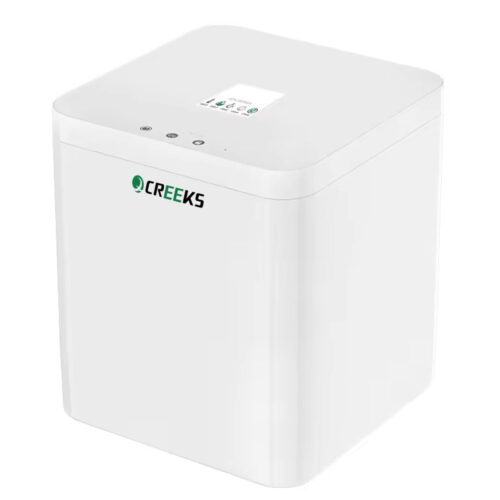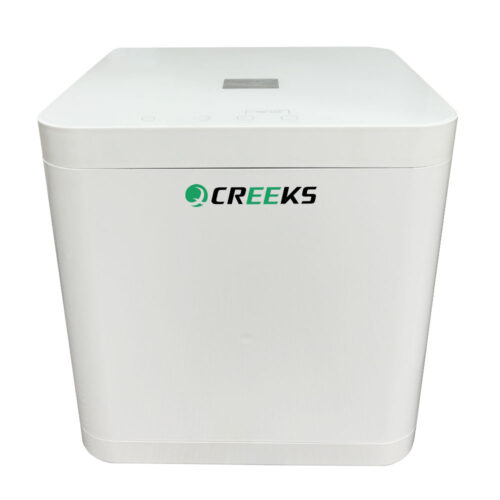What is an Organic Waste Composter?
An organic waste composter is a device that turns your food waste into compost faster. If you’re already backyard composting with a compost pile, think of it as the alternative for cleaner, more effective composting.
It’s not just for farmers or gardeners. Anyone who wants to reduce the amount of trash they produce will find a food waste converter useful.
The composter regulates temperature, moisture, and aeration so microorganisms inside thrive and break down organic materials efficiently. The process inside is still 100% natural, so all the finished compost is organic and can support plant growth.
The organic waste converter acts as a facilitator, optimizing the composting process without introducing any synthetic or harmful elements.
Benefits of Using a Food Waste Composter
- Less waste ends up in landfills to generate greenhouse gases.
- The compost maintains a healthy soil and reduces the need for chemical fertilizers in agriculture.
- Composting food waste at home or on a larger scale reduces waste disposal costs.
- Organic waste composters manage odors and keep pests at bay.
- Composters prevent the leaching of pollutants into groundwater.
- Composting encourages individuals to be more mindful of waste generation and promotes responsible consumption.
3 Effective Organic Waste Composting Techniques
When looking for home composting solutions to recycle fruit and vegetable scraps, you want to focus on one of three techniques — aerobic digestion, worm composting, and anaerobic digestion.
1. Aerobic composting means that the process takes place in the presence of oxygen. You can easily break down organic matter in a confined environment in your backyard. The systems are popular because they can hold various organic materials. Moreover, they come in all shapes and complexity levels, making aerobic digestion suitable for small-scale home composting and large-scale waste management operations.
Aerobic systems require proper aeration and moisture management to function correctly. Temperature control inside the composter is necessary to accelerate decomposition.
2. Vermicomposting uses earthworms to power the decomposition process. Redworms (Eisenia fetida) are highly efficient and produce a fine-textured, nutrient-rich compost that improves soil structure and promotes plant growth. Worm composting is a slower process than aerobic composting. Still, it’s ideal when you have limited space or must compost indoors — the system can be so compact that it fits in kitchens, garages, or even under sinks.
3. Anaerobic digestion involves microorganisms that thrive in oxygen-free environments, so the process can only occur in sealed containers. The anaerobic bacteria eat kitchen leftovers and other organic matter and produce biogas. Once captured, it can become a renewable energy source for heating, electricity generation, or cooking. Besides biogas, anaerobic systems make digestate, a nutrient-rich fertilizer that can support your gardening efforts.

Types of Home Composting Systems for Organic Waste
Aerobic Composting Systems
- Open compost piles
- Static compost piles
- Composting bins
- Tumbler composters
- Green cone composters
- Hot rot composters
Vermicomposting
- Worm bins (DIY or commercial units)
- Worm towers
Anaerobic Composting Systems
- Anaerobic chambers
- Biogas digesters
- Bokashi composters
- Septic tanks
How to Choose the Right Organic Waste Composter
It all starts with how much organic waste you generate. A small household or one with limited space only needs a compact composter, such as a countertop bin or small-scale worm bin. An outdoor compost bin or tumbler with greater capacity is better for large families or small farms. On the other hand, commercial or industrial operations dealing with substantial waste volumes may require larger-scale composting systems.
The composting method is also crucial when deciding what waste composter works best for your needs. Aerobic systems and biodigesters are suitable for various organic materials but usually require well-ventilated outdoor space. Vermicomposting and Bokashi buckets are better for indoor locations. Local regulations for organic waste management could also influence your decisions, so research and compare different products and brands to choose a compliant device.
Setting Up and Using an Organic Waste Composter
How to set up a food waste composting machine for the home?
Step 1. Choose a spot with easy access and enough space for maintenance and emptying. It should be level, well-drained, and under partial sunlight. If you opt for a worm bin indoors, find a place away from direct light but still easily accessible.
Step 2 (for vermicomposting). Prepare the area at the bottom using a bedding material like shredded newspaper or cardboard.
Step 3. Collect a mix of organic materials, including kitchen scraps (fruit and vegetable peels, coffee grounds, eggshells), yard waste (leaves, grass clippings), and brown materials (dry leaves, straw, shredded newspaper).
Step 4. Layer green (nitrogen-rich) and brown (carbon-rich) materials, starting with brown, carbon-rich material. Maintain a balanced carbon-to-nitrogen (C: N) ratio by alternating layers.
How to keep the organic waste composter working?
- Keep the composter covered to prevent pests and bad smells.
- Turn or mix the compost materials regularly to introduce oxygen.
- Maintain proper moisture levels, like a wrung-out sponge, by adding water as needed.
- Monitor inside temperature to ensure it stays between 120°F and 160°F (49-71°C).
- Harvest the compost when it’s crumbly and earthy-smelling.
- Replace any worn-out or damaged parts of the bin or tumbler. In worm bins, provide the worms with bedding and food and remove any excess moisture.
Using Compost from an Organic Waste Composter
Compost enhances soil structure, promotes nutrient retention, and fosters beneficial microbial activity. When you mix it in garden beds, it acts as a slow-release fertilizer, releasing essential nutrients over time. Compost helps retain soil moisture, suppress weeds, and regulate soil temperature when used as a top dressing or mulch around trees and shrubs.
Fresh compost can become nutrient-rich compost tea, an excellent liquid fertilizer for garden and potted plants. Mix compost with water and apply it to plants as a foliar spray. Compost tea provides an immediate nutrient boost and enhances plant resistance to diseases.
HOUSEHOLD COMPOSTER


